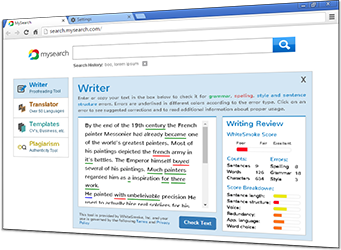English Grammar - An Introduction
At its core, the term grammar refers to either the inherent structure of words and sentences (morphology and syntax respectively) in a language; or to the study and description of this structure, published as grammar rules in books about the language. Other approaches include more topics under the term grammar: orthography (spelling, punctuation and capitalization), semantics (word meanings), phonetics and phonology (sounds) and pragmatics (language use in context).
We unconsciously use grammar all the time when we use language for speaking, listening, reading and writing. If we want to improve our English language abilities, there is no escape from addressing grammar issues. WhiteSmoke's all-in-one grammar software helps you take care of your grammar needs as you write your texts so you actually learn from your own ongoing practice. Featuring an advanced grammar checker, an innovative contextual spell checker, and patented text enrichment, you can be sure that your writing is grammatically correct.
Grammar explains how the language should be structured, using various categories. Number refers to formation of singular and plural nouns and other parts of the sentence that have to agree with number (e.g. child Vs. children) whereas Gender, a category hardly existent in English, but alive in German, regards the differences between masculine ( der Löffel, spoon) feminine ( die Gabel, fork) or even neuter ( das Messer, knife) nouns and how these affect other words in a properly phrased sentence. Tense and aspect treat the formation of verbs, from the English I write - She writes; We write - We are writing distinctions, all the way to far more elaborate verb conjugation systems of other languages. A grammatical category or element never stands alone as it influences all other parts of the structural system of a language.
Grammar topics are usually sorted in books into word grammar and sentence grammar. Word grammar sections are further divided according to the different parts of speech - content words, containing verbs, nouns, adjective and adverbs; and structure words, containing determiners, pronouns, prepositions, conjunctions and interjections. Sentence grammar relates to the construction of phrases, clauses and full sentences, all the way up to paragraphs and full texts.
English Grammar: Then and Now
Nowadays, there are modern approaches to grammar, which bring it alive and relate it to our real life, outside of outdated grammar books containing endless lists of grammar rules. The older prescriptive grammar approach, used to have students theoretically analyze sentences for correctness in literary and religious texts, as if they were training to become linguists. This was based along the lines of the traditional approach to the instruction of ancient Latin and Greek, which were not even used in speech in the Middle-Ages onwards. The purpose was preserving the formal standard usage of these languages while treating grammar as a theoretically isolated area of study.
This is now supplemented by the descriptive approach that looks at how people actually use grammar in real life conversations and texts using modern living languages. It acknowledges language change and various styles as acceptable, resulting in more than one way of saying things. Pedagogical grammar for language learning purposes teaches only those grammar rules relevant to successful practical communication themes like shopping, looking for a job or opening up a business. For example, the uses of the present perfect ( I have worked as...) for indefinite past events or events going from past to present are geared towards speaking about former work experience either during a spoken job interview or in a written letter of job application. Alternatively, perfect modal forms are used for a hypothetical discussion of alternative consequences to past actions ( could have done) or the expression of regrets on what may/should have been.
Grammar is therefore now seen, not merely as theory, but as an enabling tool for authentic language practice. As some rules still need to be taught formally, a balanced combination of all the approaches is the solution for using grammar effectively. For improving your English writing, WhiteSmoke English writing software ingeniously enriches your text after comparing it to millions of texts produced by our users worldwide and does not merely judges it based on an old-fashioned adherence to certain rules. It is not to be understood that grammar is less important today than how it may have been perceived before.
Whereas spoken language or literary dialogue may tolerate numerous grammar mistakes as part of a person or cultural group's individual style, written language of expository articles, business documents and of course academic texts must adhere to conventional grammar and style. Generally speaking, written language is more formal in both form and content than spoken language. Consequently, "She doesn't want to do nothing" (double negative) may qualify for informal coffee table chats, but not for a written letter of complaint about a worker or service provider. The conventional practice of avoiding double negatives in writing would therefore call for "She does not want to do anything."



